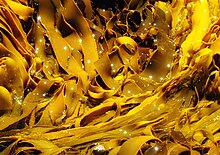
Back طحلب الكلب Arabic طحلب الكلب ARZ Laminarials Catalan Kelp Czech Lludwymon Welsh Laminariales German Κέλπιες Greek Laminariales Spanish Kelp Basque کتانجک Persian
| Kelp Temporal range: [1]
| |
|---|---|

| |
| Scientific classification | |
| Domain: | Eukaryota |
| Clade: | Diaphoretickes |
| Clade: | SAR |
| Clade: | Stramenopiles |
| Phylum: | Gyrista |
| Subphylum: | Ochrophytina |
| Class: | Phaeophyceae |
| Order: | Laminariales Migula, 1909[2] |
| Families | |
|
Agaraceae | |
Kelps are large brown algae or seaweeds that make up the order Laminariales. There are about 30 different genera.[3] Despite its appearance, kelp is not a plant but a stramenopile (a group containing many protists).[4]
Kelp grow from stalks close together in very dense areas like forests under shallow temperate and Arctic oceans.[3] They were previously thought to have appeared in the Miocene, 5 to 23 million years ago based on fossils from California.[5] New fossils of kelp holdfasts from early Oligocene rocks in Washington State show that kelps were present in the northeastern Pacific Ocean by at least 32 million years ago.[6] The organisms require nutrient-rich water with temperatures between 6 and 14 °C (43 and 57 °F). They are known for their high growth rate—the genera Macrocystis and Nereocystis can grow as fast as half a metre a day (that is, about 20 inches a day), ultimately reaching 30 to 80 metres (100 to 260 ft).[7]
Through the 19th century, the word "kelp" was closely associated with seaweeds that could be burned to obtain soda ash (primarily sodium carbonate). The seaweeds used included species from both the orders Laminariales and Fucales. The word "kelp" was also used directly to refer to these processed ashes.[8]
- ^ William Miller, III (13 October 2011). Trace Fossils: Concepts, Problems, Prospects: Chapter 13 "Zoophycos and the Role of Type Specimens in Ichnotaxonomy by Davide Olivero. Elsevier. pp. 224–226. ISBN 978-0-08-047535-6. Retrieved 1 April 2013.
- ^ Migula, W. (1909). Kryptogamen-Flora von Deutschland, Deutsch-Österreich und der Schweiz. Band II. Algen. 2. Teil. Rhodophyceae, Phaeophyceae, Characeae. Gera: Verlag Friedriech von Zezschwitz. pp. i–iv, 1–382, 122 (41 col.) pls.
- ^ a b Bolton, John J. (July 2010). "The biogeography of kelps (Laminariales, Phaeophyceae): a global analysis with new insights from recent advances in molecular phylogenetics". Helgoland Marine Research. 64 (4): 263–279. Bibcode:2010HMR....64..263B. doi:10.1007/s10152-010-0211-6.
- ^ Silberfeld, Thomas; Rousseau, Florence; de Reviers, Bruno (2014). "An Updated Classification of Brown Algae (Ochrophyta, Phaeophyceae)". Cryptogamie, Algologie. 35 (2): 117–156. doi:10.7872/crya.v35.iss2.2014.117. S2CID 86227768.
- ^ University of California Museum of Paleontology: The Miocene Epoch
- ^ Kiel, S., J.L. Goedert, T.L. Huynh, M. Krings, D. Parkinson, R. Romero, C.V. Looy. 2024. Early Oligocene kelp holdfasts and stepwise evolution of the kelp ecosystem in the North Pacific. PNAS 121: e2317054121
- ^ Thomas, D. 2002. Seaweeds. The Natural History Museum, London, p. 15. ISBN 0-565-09175-1
- ^ "Kelp," in Oxford English Dictionary (Second Edition). Oxford University Press, 1989. Retrieved 1 December 2006